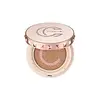What's inside
What's inside
 Key Ingredients
Key Ingredients

 Benefits
Benefits

 Concerns
Concerns

 Ingredients Side-by-side
Ingredients Side-by-side

Water
Skin ConditioningCI 77891
Cosmetic ColorantCyclopentasiloxane
EmollientGlycerin
HumectantIsononyl Isononanoate
EmollientC12-15 Alkyl Benzoate
AntimicrobialDiphenylsiloxy Phenyl Trimethicone
Skin ConditioningPropanediol
SolventLauryl Polyglyceryl-3 Polydimethylsiloxyethyl Dimethicone
Skin ConditioningOctyldodecanol
EmollientTrimethylsiloxysilicate
EmollientNiacinamide
SmoothingPropylene Glycol Dibenzoate
Skin ConditioningPropylheptyl Caprylate
EmollientSynthetic Fluorphlogopite
Isododecane
Emollient1,2-Hexanediol
Skin ConditioningDisteardimonium Hectorite
StabilisingDextrin Palmitate
EmulsifyingPolyglyceryl-4 Isostearate
EmulsifyingVp/Eicosene Copolymer
Polyglyceryl-3 Polydimethylsiloxyethyl Dimethicone
Skin ConditioningCI 77492
Cosmetic ColorantMagnesium Sulfate
Stearic Acid
CleansingAlumina
AbrasiveTriethoxycaprylylsilane
Parfum
MaskingCI 77491
Cosmetic ColorantAluminum Hydroxide
EmollientCI 77499
Cosmetic ColorantAdenosine
Skin ConditioningTrisodium Ethylenediamine Disuccinate
Ethylcellulose
Isopropyl Titanium Triisostearate
EmollientTocopherol
AntioxidantMoringa Oleifera Seed Oil
EmollientCaprylic/Capric Triglyceride
MaskingHydrogenated Lecithin
EmulsifyingCeramide NP
Skin ConditioningPhytosphingosine
Skin ConditioningSodium Stearoyl Glutamate
CleansingWater, CI 77891, Cyclopentasiloxane, Glycerin, Isononyl Isononanoate, C12-15 Alkyl Benzoate, Diphenylsiloxy Phenyl Trimethicone, Propanediol, Lauryl Polyglyceryl-3 Polydimethylsiloxyethyl Dimethicone, Octyldodecanol, Trimethylsiloxysilicate, Niacinamide, Propylene Glycol Dibenzoate, Propylheptyl Caprylate, Synthetic Fluorphlogopite, Isododecane, 1,2-Hexanediol, Disteardimonium Hectorite, Dextrin Palmitate, Polyglyceryl-4 Isostearate, Vp/Eicosene Copolymer, Polyglyceryl-3 Polydimethylsiloxyethyl Dimethicone, CI 77492, Magnesium Sulfate, Stearic Acid, Alumina, Triethoxycaprylylsilane, Parfum, CI 77491, Aluminum Hydroxide, CI 77499, Adenosine, Trisodium Ethylenediamine Disuccinate, Ethylcellulose, Isopropyl Titanium Triisostearate, Tocopherol, Moringa Oleifera Seed Oil, Caprylic/Capric Triglyceride, Hydrogenated Lecithin, Ceramide NP, Phytosphingosine, Sodium Stearoyl Glutamate
Ingredients Explained
These ingredients are found in both products.
Ingredients higher up in an ingredient list are typically present in a larger amount.
Adenosine is in every living organism. It is one of four components in nucleic acids that helps store our DNA.
Adenosine has many benefits when used. These benefits include hydrating the skin, smoothing skin, and reducing wrinkles. Once applied, adenosine increases collagen production. It also helps with improving firmness and tissue repair.
Studies have found adenosine may also help with wound healing.
In skincare products, Adenosine is usually derived from yeast.
Learn more about AdenosineNiacinamide is a multitasking form of vitamin B3 that strengthens the skin barrier, reduces pores and dark spots, regulates oil, and improves signs of aging.
And the best part? It's gentle and well-tolerated by most skin types, including sensitive and reactive skin.
You might have heard of "niacin flush", or the reddening of skin that causes itchiness. Niacinamide has not been found to cause this.
In very rare cases, some individuals may not be able to tolerate niacinamide at all or experience an allergic reaction to it.
If you are experiencing flaking, irritation, and dryness with this ingredient, be sure to double check all your products as this ingredient can be found in all categories of skincare.
When incorporating niacinamide into your routine, look out for concentration amounts. Typically, 5% niacinamide provides benefits such as fading dark spots. However, if you have sensitive skin, it is better to begin with a smaller concentration.
When you apply niacinamide to your skin, your body converts it into nicotinamide adenine dinucleotide (NAD). NAD is an essential coenzyme that is already found in your cells as "fuel" and powers countless biological processes.
In your skin, NAD helps repair cell damage, produce new healthy cells, support collagen production, strengthen the skin barrier, and fight environmental stressors (like UV and pollution).
Our natural NAD levels start to decline with age, leading to slower skin repair, visible aging, and a weaker skin barrier. By providing your skin niacinamide, you're recharging your skin's NAD levels. This leads to stronger, healthier, and younger looking skin.
Another name for vitamin B3 is nicotinamide. This vitamin is water-soluble and our bodies don't store it. We obtain Vitamin B3 from either food or skincare. Meat, fish, wheat, yeast, and leafy greens contain vitamin B3.
The type of niacinamide used in skincare is synthetically created.
Learn more about NiacinamideTocopherol (also known as Vitamin E) is a common antioxidant used to help protect the skin from free-radicals and strengthen the skin barrier. It's also fat soluble - this means our skin is great at absorbing it.
Vitamin E also helps keep your natural skin lipids healthy. Your lipid skin barrier naturally consists of lipids, ceramides, and fatty acids. Vitamin E offers extra protection for your skin’s lipid barrier, keeping your skin healthy and nourished.
Another benefit is a bit of UV protection. Vitamin E helps reduce the damage caused by UVB rays. (It should not replace your sunscreen). Combining it with Vitamin C can decrease sunburned cells and hyperpigmentation after UV exposure.
You might have noticed Vitamin E + C often paired together. This is because it is great at stabilizing Vitamin C. Using the two together helps increase the effectiveness of both ingredients.
There are often claims that Vitamin E can reduce/prevent scarring, but these claims haven't been confirmed by scientific research.
Learn more about Tocopherol